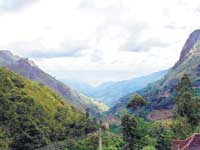| Plus |
|
|||
|
Unveiling
Uva
A three-hour drive from Kandy along the picturesque Randenigala Road brings you to the district of Badulla. Water greets you everywhere. Waterfalls cascade, rivers meander through green valleys and huge expanses of blue reservoirs spread alongside the road for many many kilometres. The scenic splendour along this drive to Badulla on the Randenigala Road is spectacular. One passes the Victoria, Randenigala and Rantambe Sanctuaries through sometimes dense forest cover. After 6 p.m., this road is closed to avoid close encounters with elephants. Along the way, you pass the Victoria and Randenigala reservoirs, the Minipe ela and the Uma waterfall and many other little waterfalls. About six km from the Badulla town, on the Badulla-Mahiyangana road is the entry point to view the 60-metre high Dunhinda waterfall. Shrouded in many mysterious legends, the most famous story is that the cave behind the waterfall holds treasures belonging to a prince of Uva, Kumarasinghe. Many have tried to brave the waterfall to enter the cave but not succeeded. The
water cascades in billows of misty, smoky foam, hence the name Dunhinda.
The falling water has churned a deep round pool in the rock below.
Behind the curtain of water is the cave, which has lured many to
their death, but unlike in the days gone by, visitors can make use
of the wide viewing balcony to see the magnificence of the misty
shrouds of water vapour. Though sometimes tricky with boulders and fallen trees to climb over, the path is not difficult for the average active person. The pungent smell of earth pervades and at one point there is a narrow suspension bridge over a ravine which one has to go across. The wooden planks swing as you walk along over the precipice. Inquisitive Torque monkeys, big and small sit along the pathway hoping for tidbits to fall their way, but feeding them is not to be encouraged. Alongside the pathway at convenient points under huge trees, villagers have set up their little boutiques, selling hot tea with kithul jaggery and cool sweet juice from local oranges. For the more adventurous, herbal teas of “Belimal” and “Ranawara Mal” are available. Packeted neatly to be taken away by passersby are kithul flour, habala pethi, kotala himbutu (the bark of a tree that is boiled and drunk by diabetes patients), sandalwood powder, venivelgeta pieces, kithul seeds, madu seeds (out of which rotti and pittu are turned out) and many other not so familiar fare to city dwellers. Seats made of thin bamboo planks adorn the sides of the kiosks so that one may pause to rest and sip a cool drink, which is also available at the handsome price of Rs. 40 a bottle (the price not so high when you take into consideration the distance from the main road and the trek). Another attraction is the Dova rock temple bedecked with colourful murals and inscriptions of the 1st century BC that bring out stories from the Buddha’s life. The unfinished statue of the Buddha standing eight metres high is hewn from the rock in the backdrop of the temple. The picturesque Ella Grand Motel, once the Ella Resthouse is still run by the Hotels Corporation. As we sat on the patio having lunch and admiring the view, hundreds of butterflies kept flying past. We were told that they were heading towards Adam’s Peak. One gets a breathtaking view of the famed “Ella Gap’, the gap in the valley between the mountains, from here. On a clear day you can see up to Moneragala, or sometimes even Wedihitikanda in Kataragama. The mountain on the right is called the Ravana mountain. It is here that one finds the famous Ravana cave, where the King of Lanka is supposed to have hidden Seetha, the Indian princess he abducted. It is accessible to anyone willing to scramble up the mountainside. We were told there is a tunnel from this cave that leads to the Dova temple. The picturesque Ravana Ella waterfall begins its journey just below this cave. Don’t
miss the Bogoda Bridge Bogoda can be reached from the bridge at Hali Ella, on the Keenakele Road. At Jungulla a gravel road leads to the bridge and the temple. This unique bridge, the only one of its kind to be found in Sri Lanka, is made of wood and has a roof with flat tiles like that of the Kandyan period. The Bogoda bridge (which has now been renovated by the Archaeological Department) is believed to have been built by King Walagamba and was originally exquisitely done with no bolts or nuts. Crossing the bridge one comes to the Bogoda Raja Maha Viharaya. Alongside the rock paintings in the temple is an ancient rock inscription in Brahmi script. We also saw a large cave and it is said that King Walagamba hid here when fighting invaders. Also visible is a large tunnel and further in one sees that it has caved in. It is believed that there was a secret route to Kandy through the underground tunnel . |
||||
Copyright © 2001 Wijeya Newspapers
Ltd. All rights reserved. |
 Uva
offers many sights for the adventurous traveller. And for those
looking to escape the heat and dust of the city, but not to crowded
Nuwara Eliya, Uva offers attractions aplenty.
Uva
offers many sights for the adventurous traveller. And for those
looking to escape the heat and dust of the city, but not to crowded
Nuwara Eliya, Uva offers attractions aplenty. No
visitor should leave Uva without taking a look at the Bogoda Bridge
spanning the Gallanda Oya which can be seen when one proceeds along
the Mahiyangana Road to Hali Ella.
No
visitor should leave Uva without taking a look at the Bogoda Bridge
spanning the Gallanda Oya which can be seen when one proceeds along
the Mahiyangana Road to Hali Ella.